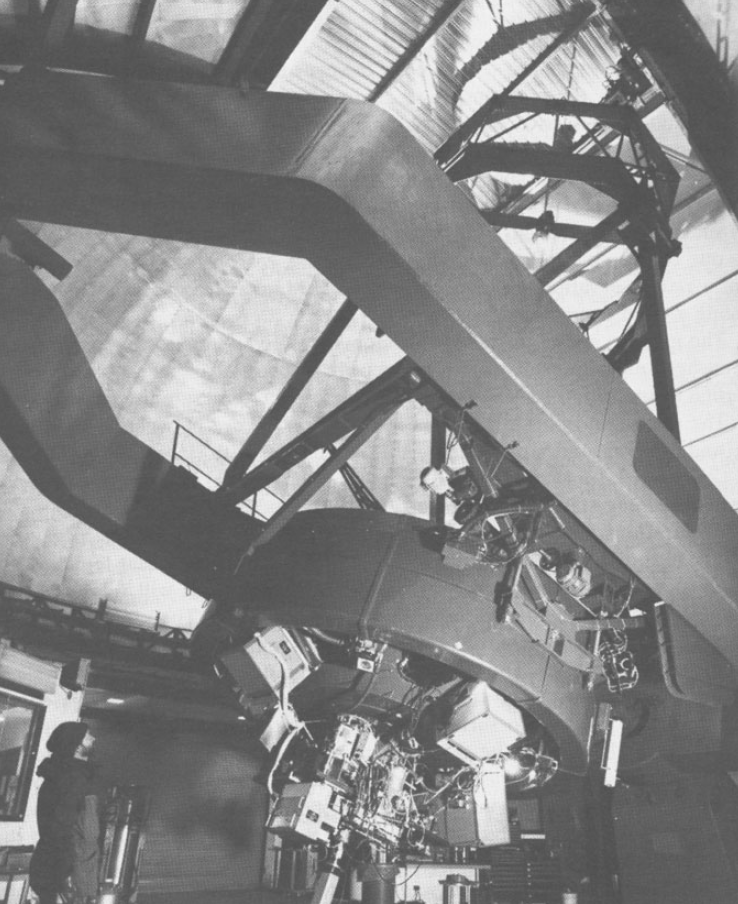
Infrared astronomy
 المؤلف:
A. Roy, D. Clarke
المؤلف:
A. Roy, D. Clarke
 المصدر:
Astronomy - Principles and Practice 4th ed
المصدر:
Astronomy - Principles and Practice 4th ed
 الجزء والصفحة:
p 393
الجزء والصفحة:
p 393
 3-9-2020
3-9-2020
 1737
1737
Infrared astronomy
For many years, photographic plates have been able to record images for radiation beyond the red sensitivity of the eye and, quite legitimately, observations made by these means were referred to as infrared astronomy, the wavelength region covered being from about 7500 to 12 000 A˚ . More recently, other detectors have been developed which are more efficient for infrared measurements and the spectral range has been extended to the tens of micrometres, there being several windows for which

Figure 1. The 3.8 m United Kingdom Infrared Telescope (UKIRT) at Mauna Kea, Hawaii. (By permission of the Royal Observatory, Edinburgh.)
molecular absorption by the atmosphere is sufficiently low for ground-based observations to be made. Water vapour is one of the chief absorbers and it is for this reason that the best sites for infrared observation are high, the station at Mauna Kea in Hawaii at 4200 m being a good example. The modern age of infrared astronomy was given impetus by experiments launched on balloon platforms but recent emphasis has been placed on the design of special ground-based infrared telescopes and satellite observations.
The main atmospheric windows in the infrared are between 1 and 5 μm, 7 and 13 μm and around 20 μm. Passbands with labels J (1·25 μm), K (2·2 μm), L (3·4 μm), M (5·0 μm) and N (10·2 μm) have been developed for performing standard photometry.
Application of Wien’s displacement law for a temperature of 290 K shows that the peak emission from a black body at that temperature is at 10 μm. Thus, many measurements in the
infrared relate to cool bodies, for example, solar system objects and cool stars. The same calculation also gives an immediate hint to some of the problems and difficulties of making infrared observations. The telescope itself will radiate strongly in the infrared and special care must be given to its design and structure. For optical telescopes, it is common practice to surround the secondary mirror by a baffle tube to prevent stray light from the sky entering the system. In the infrared, such an arrangement is an embarrassing source of radiation and is generally removed, particularly for observations at 5 μm and beyond. The optical components within the subsidiary analysing equipment are invariably refrigerated and the detector itself cooled to liquid helium temperatures. Again, by virtue of its temperature, the atmosphere between the incoming radiation and the telescope also radiates strongly and the infrared brightness is continually changing. This problem is dealt with by chopping frequently between the source and a nearby sky position and integrating the difference signal. The chopping may be performed by having a secondary mirror which ‘wobbles’ between two positions. A specially designed infrared telescope known as UKIRT (United Kingdom Infrared Telescope) is depicted in figure 1.
Modern infrared detectors include ‘thermal’ devices and solid state photo-conductive and photovoltaic cells. Perhaps the most widely used detector is the germanium bolometer, operated at liquid helium temperatures. Essentially, it is a gallium-doped germanium chip with a blackened (for absorption and increased efficiency) sensing area of less than 0·1 mm2. The sensing depends on the change in electrical resistance of the chip as it absorbs the infrared radiation and increases its temperature.
The sensitivity of the infrared detector is normally characterized by its noise equivalent power (NEP), this being defined as the power required of any incident radiation such that it would produce an rms (root mean square) value of the noise. In other words, the NEP is the incident power required to obtain a signal-to-noise value of unity. A good value for the NEP of a germanium bolometer is of the order of 7 × 10−15 WHz−1/2.
A well-known success has been the IRAS which, in 1983, carried a refrigerated 57 cm telescope into orbit, surveying virtually the whole of the sky at four wavelength bands centred at 12, 25, 60 and 100 μm. The telescope optics and the main system were maintained below 5 K for the 11 months of the survey. The focal plane of the telescope held a template with a series of 62 slots providing different fields of view and followed by detectors operating at 1·8 K. The detector pattern was designed so that any source crossing the field was monitored by at least two of the detectors in the same wavelength band. Analysis of the thousands of recorded infrared sources has provided a new reference catalogue and has opened up new areas of astrophysical research.
 الاكثر قراءة في مواضيع عامة في علم الفلك
الاكثر قراءة في مواضيع عامة في علم الفلك
 اخر الاخبار
اخر الاخبار
اخبار العتبة العباسية المقدسة


